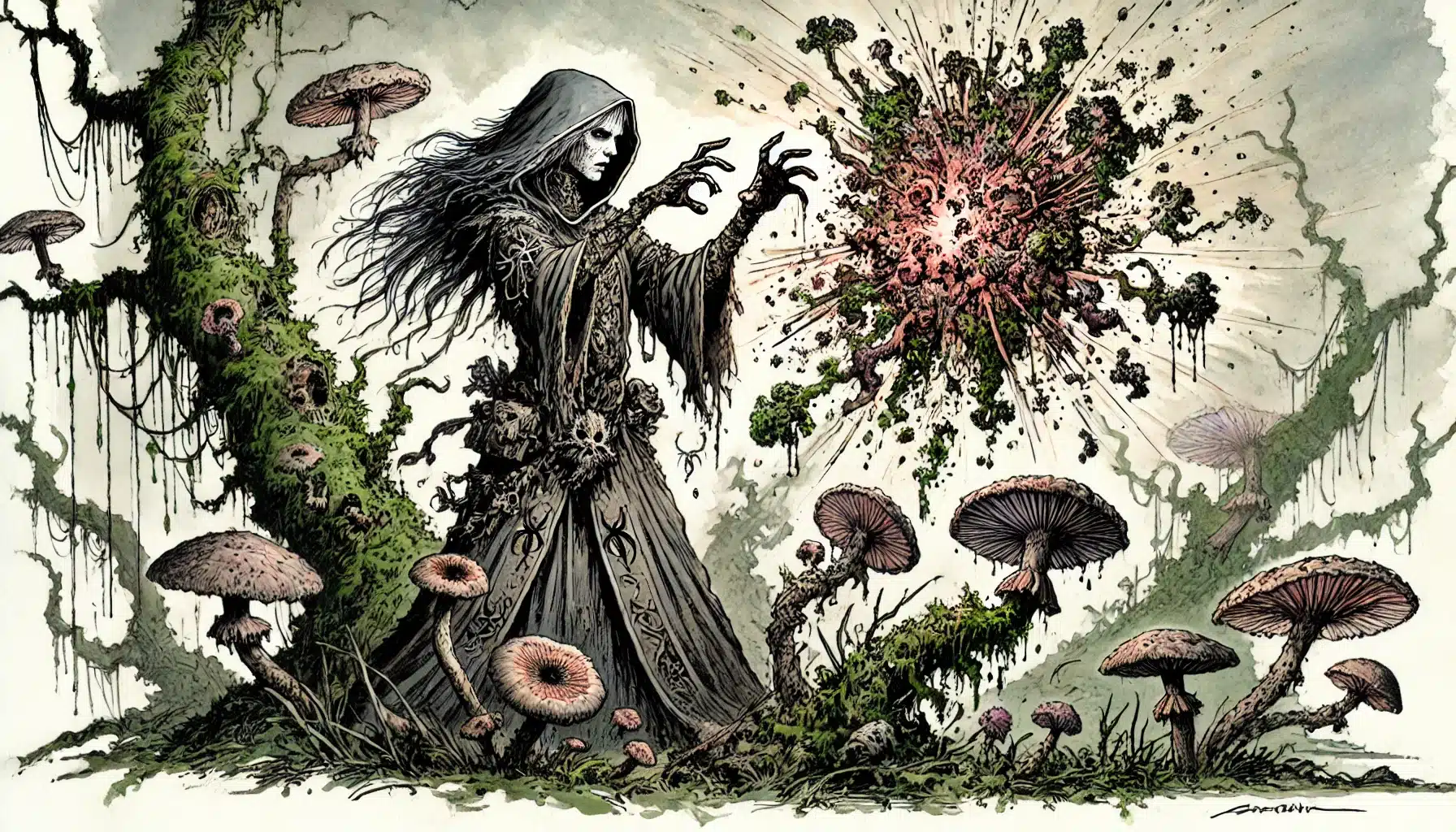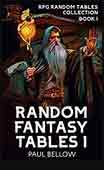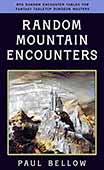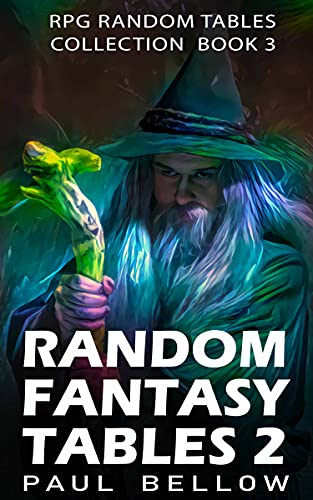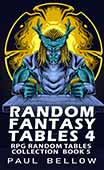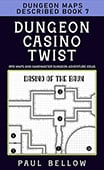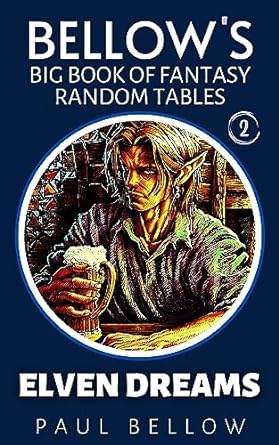What is magic, if not the language of possibility? In Dungeons & Dragons, the core spell schools—Evocation, Illusion, Necromancy, and their kin—form the scaffolding of spellcraft. But as any daring adventurer knows, it is beyond the codified, within the overlooked margins, that the true wonders are born. Homebrew magic schools don’t just expand your spell list—they enrich your world, adding philosophies, rivalries, and mysteries that transform magic from a toolkit into a living, ever-evolving legend.
Imagine each school as both a university of thought and a spiritual tradition. Arcane scholars argue, priests prophesy, rebels scrawl heresies—each school’s signature spell is more than a flourish. It’s a worldview captured in a single potent moment. Whether that manifests as soul-bonding rituals, time-shattering strikes, or tattoos that pulse with midnight flame, these effects reveal what that school believes magic truly means.
For Dungeon Masters, introducing custom schools is a siren’s call—irresistible hooks for rivalries, plotlines, political upheaval. What kind of world arises when the School of Witherhex, master of rot, forms a secret sect within druidic circles? How does society react when the Dreamscript order begins selling “sleep insurance?” These are engines for intrigue, adventure, and moral conflict. And for players, new schools unlock tantalizing new archetypes, tempting them into stories—body-modifying glyph scribes, sonic duelists, soul-weaving paladins—that simply don’t fit anywhere else.
Each of the twelve schools below offers more than mechanical novelty. Each is a window into an ethos: a spell as a manifesto. Together, they don’t just provide fresh magic for your campaign—they expand what it means to forge an identity around spellwork, inviting you to think of magic not just as a system, but as a living, breathing culture. Ready your spellbook.
- How to Use Custom Magic Schools in Your Game
- School of Echobinding – Spell: Sonic Reverb
- School of Emberglass – Spell: Shatterflame Halo
- School of Arcanogeometry – Spell: Sigil Prism
- School of Witherhex – Spell: Bloom of Rot
- School of Dreamscript – Spell: Oneiric Loop
- School of Soulweaving – Spell: Spirit Lattice
- School of Chronoblade – Spell: Sunder Time
- School of Ironcall – Spell: Magnetize Bones
- School of Aethermancy – Spell: Null Veil
- School of Glimmertruth – Spell: Revelation Lance
- School of Inkblood – Spell: Glyphpulse
- School of Puppetry – Spell: Marionette Curse
- Tips for Balancing and Expanding Custom Magic Schools
- Final Thoughts on Homebrew Magic Schools
How to Use Custom Magic Schools in Your Game
Integrating homebrew magic schools into your campaign is more than slotting in a spell—as with introducing a new religion or political faction, it should feel like an event. Start with narrative positioning. Is this school a long-lost tradition, its secrets jealously protected by cryptic orders? Perhaps it’s the trademark of a prestigious university, a badge of status among arcanists. Maybe it’s outlawed, whispered about in the taverns as the source of ancient cataclysms. The social and historical gravity you assign to a school gives it weight, inviting roleplay beyond mere mechanics.
Mechanically, consider the ramifications of access. Will only specific subclasses, backgrounds, or NPC mentors teach these spells? Is the knowledge traded among rogue wizards or hidden within enchanted grimoires? Take into account how the spell’s effects interact with established rules. If a particular school can break concentration rules, summon new types of minions, or alter time, what checks and balances exist? Granting power is all about intention: Is this a unique reward, a campaign-wide change, or a personal secret unlocked through intense questing?
Try my AI Tabletop RPG generators...and an extensive library of content!
Balance is (as always) paramount. Homebrew schools should have clear strengths, but also unique vulnerabilities. A school that manipulates time, for example, might draw the ire of planar authorities or disrupt magical ley lines, causing unpredictable side effects. Requiring rare reagents, difficult initiations, or risky side effects brings nuance. You don’t want every wizard instantly flocking to the new shiny spell—you want the decision to carry in-game meaning.
Above all, strive for thematic cohesion. Encourage players to adopt roleplaying quirks, philosophies, or rivalries that stem from their chosen school. Allow your world to react, whether through antagonists, patrons, or institutions—let the adoption of a custom school spark stories. The more you entwine the spell’s mechanics with narrative ripples, the more immersive—and memorable—your magical experiment becomes.
School of Echobinding – Spell: Sonic Reverb
The School of Echobinding is less about brute force and more about rhythm, memory, and the power of echoes. Practitioners study magical “resonance”: the ripples that every action and spell leaves in the weave of reality. Their magic harnesses repetition, mirroring, and deferred consequence, often channeling energy through music, rhythm, or reverberating movement.
Picture a sorcerer who counterattacks not with a direct bolt but with the ghost of a previous spell—an echo that bites just when you thought the threat was past. Explosive applause, the rhythmic pounding of a staff, a voice amplified into a weapon—all become tools for the Echobinder. They shape magic to respond, to bounce, to linger in ways both strategic and disorienting.
⚔️ Fantasy RPG Random Tables Books
Make life as a Gamemaster easier…
If you play Dungeons & Dragons, Pathfinder, or other fantasy RPGs, this
RPG random tables series
is packed with encounters, NPCs, treasure, and more. Available in eBook or print—either way, you’ll have a wealth of adventure ideas at your fingertips.
Their signature, Sonic Reverb, exemplifies this concept: a spell that makes magical energy reverberate and repeat, allowing for creative timing and devastating cascades. It’s a spell of relentless recurrence.
Mechanical Effects and Uses for Sonic Reverb:
- When you deal thunder or force damage with a spell, Sonic Reverb may repeat a portion (e.g., half damage) at the start of your next turn.
- Enemies struck are marked with a magical “echo.” If hit again, the echo detonates for extra damage.
- You may choose to store the reverb and release it as a reaction when a creature casts a spell within range.
- Affected targets make a second saving throw at disadvantage if they failed the first one.
- Chain the reverb: if two marked enemies are within 15 feet of each other, the echo “bounces” between them.
- Once per short rest, you can apply Sonic Reverb to a cantrip, making it echo for free.
- Charge up: for each consecutive round you don’t release the echo, the detonation grows stronger (up to a cap).
- Spend a spell slot to detonate all echoes in an area, creating a rolling shockwave that travels in a straight line.
- Stack multiple echoes on a single enemy; upon triggering, each inflicts extra damage and a stacking Stunned chance.
Sonic Reverb injects fresh tactical tension into combat. DMs can use it to punish predictable actions—an early alpha strike might result in a later pulse of damage. It also introduces a sense of rhythm to encounters. Players must weigh whether to finish a marked target quickly or risk the lingering danger of multiple echoes.
This spell is a natural fit for musical-themed characters, thunder sorcerers, or anyone who wants to visually disrupt the flow of battle. Expect your table to lean in during every echo, listening for the spell’s signature “beat drop” as the next wave of magic hits.
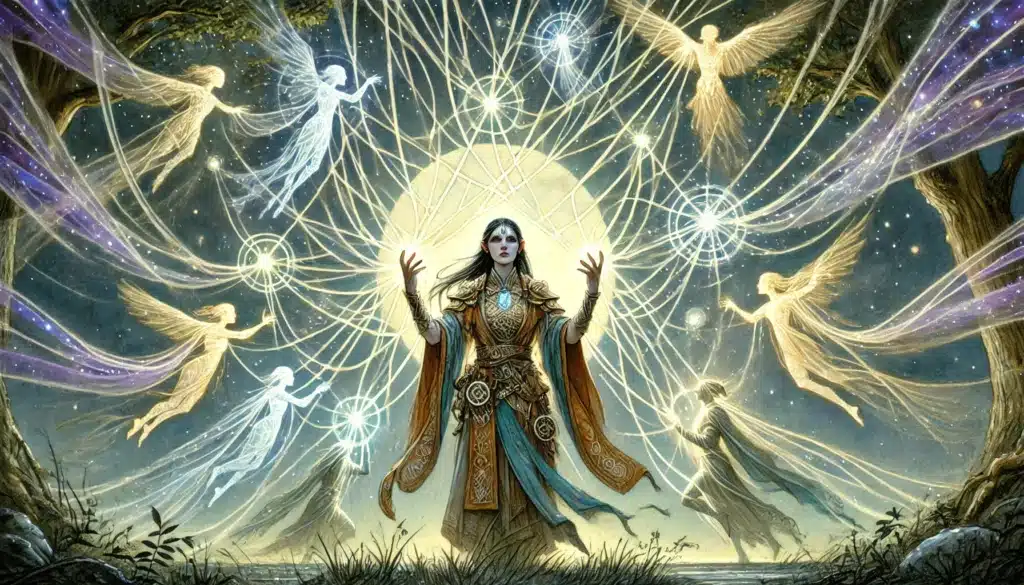
School of Emberglass – Spell: Shatterflame Halo
Emberglass is the collision of fire’s passion and glass’s lethal fragility. This school produces spells laced with molten shards—burning, brittle, beautiful. Its adherents are often seen as unstable geniuses or dangerous fanatics, drawn to the allure and terror of self-destructive power. Expect shimmering glass cloaks, ignition tattoos, and fragments that burn where they fall.
To wield Emberglass is to walk a razor’s edge. Its spells reward recklessness and punishing proximity, offering explosive reward for those who can endure a little pain. Wizards might glassify their own blood, setting it ablaze, or ignite the air with shrapnel that tears skin and will alike.
Shatterflame Halo, the school’s signature, envelops the caster or target in a corona of burning glass—a shield and a bomb, all in one. The spell detonates under the right circumstances, inflicting both fire and slashing devastation.
| Effect Type | Damage Breakdown | Situational Trigger |
|---|---|---|
| Reactive Burst | 2d6 fire + 2d6 slashing | Struck by melee attack |
| Explosive Shield | 3d8 fire, 1d8 slashing (cone) | Dropped below 50% HP |
| Area Detonation | 2d10 slashing in 10-ft radius | Caster spends reaction after spell |
| Chain Fragments | 1d6 fire, 1d6 slashing (to 3 targets) | Halo targeted by Dispel Magic |
| Halo Collapse | 4d6 slashing (caster also takes 2d6) | End of spell’s duration |
Shatterflame Halo is a visual feast—imagine shards bursting through flames, raining sparkling destruction. Yet, it comes with a risk: getting too aggressive might backfire, and enemies who learn the triggers can try to set it off at the wrong moment.
This is a spell that rewards daredevil tactics and paints high-action scenes in burning glass. It’s perfect for high-stakes duels, sieges, or the last stand where every strike could be the match—or the shatter—that decides your fate.
School of Arcanogeometry – Spell: Sigil Prism
Arcanogeometry is the arcane pursuit of structure, symmetry, and the unyielding truth of mathematics. These mages treat the battlefield as a shifting grid, deploying angles and mirrored surfaces as both weapons and defenses. Their robes are patterned like fractals; their spells inscribe glowing blueprints in the air.
For students of this school, magic isn’t wild—it’s algorithmic. A precise flick of the wrist generates a field of perfect triangles; a measured chant splits a fireball at a right angle. Foes may find their own spells twisted or rebounded by geometric genius.
⚔️ Fantasy RPG Random Tables Books
Make life as a Gamemaster easier…
If you play Dungeons & Dragons, Pathfinder, or other fantasy RPGs, this
RPG random tables series
is packed with encounters, NPCs, treasure, and more. Available in eBook or print—either way, you’ll have a wealth of adventure ideas at your fingertips.
Sigil Prism, their calling card, forms mirrored sigils that refract, redirect, and duplicate magical effects. The unpredictability lies not in randomness but in perfect, inscrutable order.
Creative Effects for Sigil Prism:
- Bend a straight-line spell (like Lightning Bolt) around a corner or through an ally.
- Cause a Magic Missile or ranged spell attack to bounce once to an additional target.
- Reflect a hostile spell back at its originator (with a difficulty check).
- Create a temporary mirrored double (illusionary clone) on the battlefield.
- Split an AoE spell into two smaller, separate prisms each with half the power.
- Reshape a wall spell (like Wall of Force) into a prismatic dome.
- Generate geometric “trap zones”—stepping inside triggers a burst of stored spell energy.
- Pair two prisms: damage passing through the first is enhanced by the second.
- Pierce magical shields by angling your spell for maximum effect.
- Disrupt magical scrying by scattering the arcane “signal” through maze-like reflections.
- Produced light is kaleidoscopic, making it hard for enemies to aim (causing disadvantage).
- Allow the placement of a magical trap that only operates if angles are preserved (puzzles/traps).
Sigil Prism lets you write magical geometry into the campaign. A DM might design dungeons of “living math,” or fights where the battlefield literally rearranges as prisms are deployed. Strategic players will change encounter layouts, forcing both sides to adapt.
Spellcasters who embrace Arcanogeometry delight in precision, anticipating moves, and showing off their mastery by outwitting both enemies and puzzles with the perfect angle.

School of Witherhex – Spell: Bloom of Rot
Witherhex is the unwholesome flowering of decay, blight, and fungal domination. Once-noble druids, corrupted by anger or grief, nurture spells as much about despair as life. Their grimoires are bound with mold-spotted leather; their rituals summon wilting vines and clouds of spores. In Witherhex’s hands, death is not an end, but the means to a gruesome rebirth.
This is the school of aggressive decay—the power to rot armor, foul water, and sicken armies from afar. Witherhex mages know how to turn the battlefield itself into a death trap, and their signature spell does just that.
Bloom of Rot infests an area or enemy with fast-spreading fungal corruption. The spell is less a single punch and more a tide—slow, relentless, and devastating.
Thematic Applications for Bloom of Rot:
- Infest terrain, causing any creature that enters or starts its turn within to take necrotic damage and risk becoming Poisoned.
- Infect weapons or armor, reducing their effectiveness and causing lingering infections.
- Spread fungal spores to nearby creatures at the start of each round.
- Cause wounds to become festering, stacking damage each round until cured.
- Animate dead or dying plants within 30 feet into entangling, hostile flora.
- Rot the ground, making it difficult terrain with a slime trail.
- Lingering “miasma” causes failed saving throws to lower Constitution temporarily.
- Enemy spellcasters must succeed on a check or find their spells disrupted by fungal hallucinations.
- Mark a bloodied enemy; if they die, the rot spreads explosively in a 10-foot radius.
- Each time a creature is healed, Bloom of Rot may reduce the effect, representing persistent infection.
- Mimic natural diseases, complicating magical healing for days after exposure.
Bloom of Rot applies pressure over time, ideal for drawn-out fights or war-of-attrition campaigns. Its true horror is cumulative—an area becomes more deadly the longer the spell lasts, and repeated exposure can cripple even hearty adventurers.
For DMs, this spell is a tool for environmental storytelling. The battlefield transforms into a living (and dying) character, ratcheting up dread and raising stakes as nature itself rebels and rots.
School of Dreamscript – Spell: Oneiric Loop
Dreamscript mages see the world as a woven tapestry of thoughts, memories, and half-remembered stories. Their magic coils about the sleeping mind, disturbing comfort, reshaping reality through paradox and recursion. These casters are both feared and sought after as diplomats, spies, and saboteurs.
Dreamscript is the ultimate school of chaos. Its practitioners walk the blurred border between waking and dreaming, guiding (or ensnaring) others in illusion, déjà vu, and mental recursion. Their signature spell is a test not only of magic, but of sanity.
Oneiric Loop chains an enemy—or a moment—in a recursive magical pattern. Each repetition brings both opportunity and peril, as the dream blurs into reality and back again.
Sample Dream Loops Players Might Experience:
- Forced to repeat a failed saving throw against the same effect on their next turn.
- Relive the last action taken, unable to break the pattern until passing a save.
- Repeat the words of their last speech or battle cry, compulsively, until interrupted.
- Suffer the same damage they just inflicted on an enemy (emotional feedback).
- All spells they cast are repeated, with the same or reduced effect, for the next round.
- Witness hallucinatory “phantom” versions of allies reenacting past actions.
- Skills checks made in the looped state are made with disadvantage as reality blurs.
- In combat, the same enemy turn or action is replayed, forcing tactical adaptation.
- Players lose their sense of time, causing rounds to be skipped or repeated at DM discretion.
- Echoing emotional states—fear, anger, love—amplified until the loop ends.
- Remember secrets they never learned, raising paranoia.
Oneiric Loop is the battleground of the mind—a tool to destabilize enemies, force repetition, and turn opponents’ strengths into traps. Its chaotic nature invites delirious roleplaying moments, surreal visuals, and strategic panic.
A DM can use this spell to sculpt entire encounters that blur the boundary between dream and waking, bringing a new level of psychological intrigue and confusion to the table.
School of Soulweaving – Spell: Spirit Lattice
The Soulweaving school draws power from shared fate, unity, and the idea that bonds—spiritual, emotional, or literal—are the wellspring of all real magic. Practitioners are healers, mediums, even tacticians, tending the threads of connection as fiercely as any blade.
To “weave” souls together is to accept risk and sacrifice, to heal or empower not through isolation, but through collective effort. Their magic celebrates communion, at both its most transcendent and its most perilous.
Spirit Lattice is part shield, part lifeline, and part executioner’s blade—linking fates so tightly that victory and defeat become a shared experience.
| Linked Party Size | HP Sharing Ratio | Risk of Overextension |
|---|---|---|
| 2 | 1:1 (full split) | If one dies, both drop to 0 HP |
| 3 | 2:1 (closest share) | If two drop, third drops to 0 HP |
| 4 | 2:1:1 (halved) | Each unconscious party member drops others by 10 HP |
| 5 | 3:2 (majority rules) | Linked exhaustion if single target dies |
| 6 | 4:2 (split) | If one fails a death save, others take psychic damage |
| Variable (NPCs) | Custom | Risk: sudden mass HP drain if overloaded |
Tactically, Spirit Lattice is a double-edged sword of unparalleled drama. Sacrifice, risk, and trust define its use. A well-timed lattice can pull a party through a boss’s deathwave—but it can just as easily doom all to a shared fate if luck turns.
Emotionally, this spell spotlights loyalty, leadership, and the weight of collective consequence. Few spells can so immediately make a “heroes never abandoned” moment sing—or break every heart at the table.
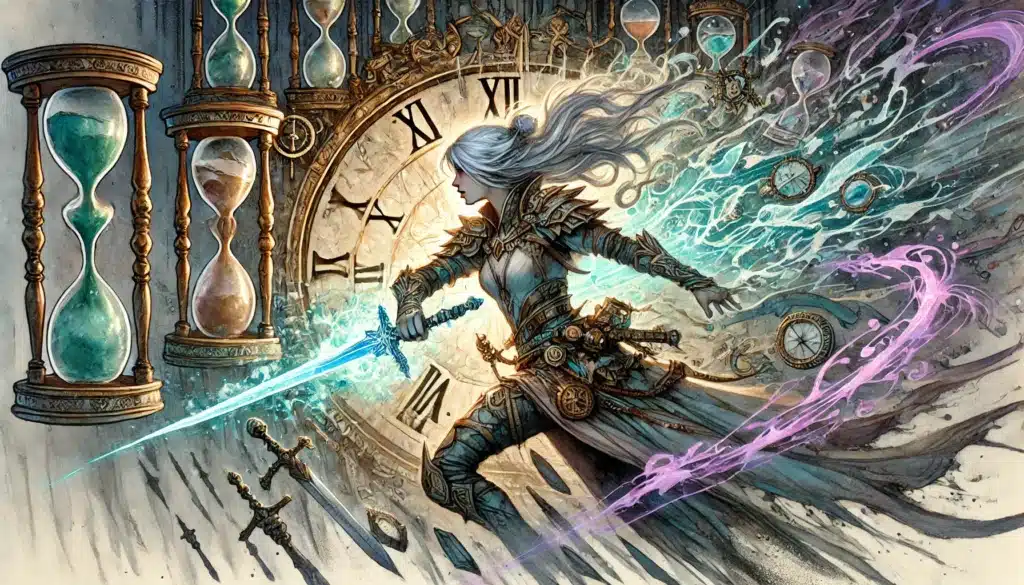
School of Chronoblade – Spell: Sunder Time
Chronoblade is magic made weapon through the fracture of chronology. Casters disrupt cause and effect, hacking seconds from an opponent’s life, delaying wounds, stealing the future. Their temporal magic is neither subtle nor merciful—every cut is a wound in history itself.
This is the school of relentless momentum and cinematic pauses—a turn-based reality hijacked by bursts of speed or missing moments. Chronoblade wizards and warlocks are dreaded, for their spells can make a foe’s last heartbeat arrive… before the attack lands.
Sunder Time is the violence of time made manifest, a spell that untethers actions from their effects—delaying, echoing, or compounding them for maximum chaos.
Combat Effects of Sunder Time:
- Delay all damage dealt to a target until the end of their next turn—stack and drop it at once.
- Skip an enemy’s action or reaction for a round; it “catches up” as double effect the next time.
- Arcane “echo attack”: an additional attack triggers after a number of rounds.
- Mark an enemy; if they die within three rounds, explode with temporal backlash (AoE).
- Suspend a spell’s condition (e.g., Paralyzed) for 1d4 rounds, then apply at once.
- Self-haste: take two turns in a row, then skip your next one.
- Stasis shield: become immune to an attack, but the blow lands all at once later.
- Delay a healing effect; stack several sources, then heal all at once (massive clutch save).
- Cause enemy saves to be “banked” and forced all together, risking overwhelming failure.
- Skip concentration checks, but if lost, all suppressed effects happen at once.
- Temporarily erase terrain features (like walls), making them reappear a round later.
Chronomancy is dangerous to the narrative fabric—use it sparingly and carefully. Even so, it provides unforgettable set pieces: duels where seconds are auctioned or boss fights that detonate with pent-up cause-and-effect.
In moderation, Sunder Time transforms climactic battles into dizzying, cinematic puzzles. Encourage players to wield it carefully, lest time’s retribution be as swift as its power.
School of Ironcall – Spell: Magnetize Bones
Ironcall practitioners bend the world’s magnetism to their will, treating steel and flesh as opposites on the same axis. Spellcasters from this school look like warriors—heavy armor, battered shields, nails hammered into leather bands. Their magic is direct, brutal, and satisfyingly physical.
This is magic for blacksmiths, warpriests, and those who want tangible effects on the battlefield. Ironcall wizards pull swords from hands, pin armored foes to the ground, and turn dropped metal into swirling storms of shrapnel.
Magnetize Bones is their signature: a spell that laces a foe’s skeleton with magnetic force, making them the center of a battlefield’s chaos.
Battlefield Applications of Magnetize Bones:
- Disarm enemies, pulling their metal weapons and shields from their grip.
- Pin armored foes to walls, floors, or each other with irresistible force.
- Draw loose weaponry or shrapnel through a target, causing piercing damage.
- Cause metal projectiles to seek the magnetized target, gaining advantage to hit.
- Repel incoming metal attacks, granting brief resistance.
- Twist metal objects into immobilizing shapes around the enemy.
- Attract coins, stealing pouches and causing embarrassing, clattering distractions.
- Interfere with enemy spellcasting components (metal ones are useless).
- Pull rings, necklaces, or armor pieces dangerously tight, inflicting constriction damage.
- Temporarily “arm” a target with a shield or weapon they cannot control, causing confusion.
- Magnetized earth or rock transforms into hazardous difficult terrain around the spell target.
Ironcall is about bodies, weight, and presence. These spells make every movement matter—position, equipment, and even the physical makeup of your enemies come into play.
⚔️ Fantasy RPG Random Tables Books
Make life as a Gamemaster easier…
If you play Dungeons & Dragons, Pathfinder, or other fantasy RPGs, this
RPG random tables series
is packed with encounters, NPCs, treasure, and more. Available in eBook or print—either way, you’ll have a wealth of adventure ideas at your fingertips.
This school easily anchors a frontline, battle-mage playstyle. The result is a caster who feels at home smashing swords and shields, commanding center stage in any conflict.
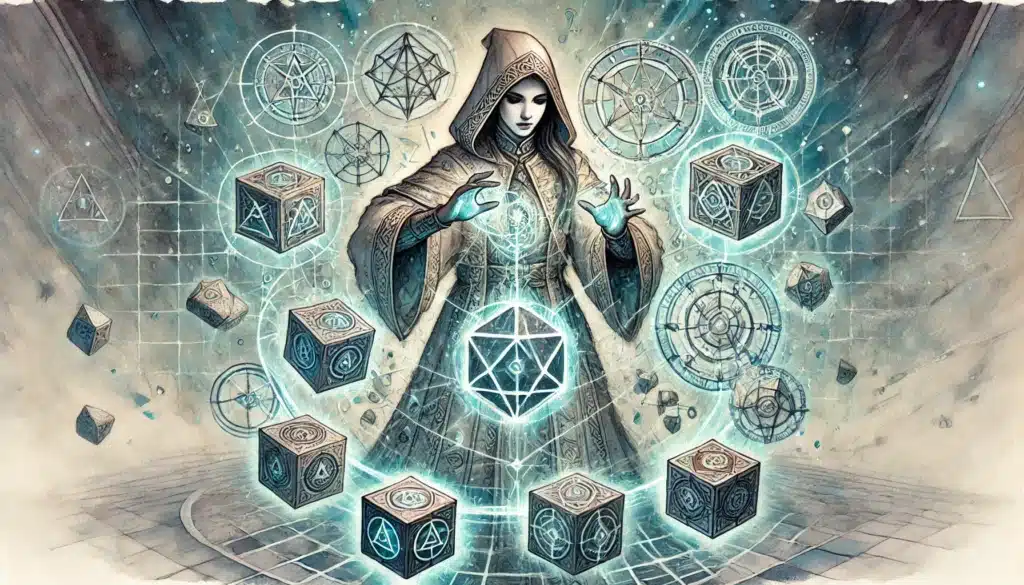
School of Aethermancy – Spell: Null Veil
In a world overflowing with raw magical power, Aethermancy offers the counterpoint—restraint, suppression, and stability. Its initiates learn control above all. Grim-robed aethermancers are as much scholars as they are spellbreakers, tasked with neutralizing magical threats and extinguishing disasters before they spread.
Aethermancy spells absorb, smother, or dispel magical chaos. The Null Veil is a signature example—a zone of stilled, absolute calm. Here, magic flickers and fails, allowing only careful, deliberate spellwork to succeed.
| Radius of Effect | Magic Types Nullified | Counterplay Options |
|---|---|---|
| 10 ft | Cantrips, minor illusions | Step outside area |
| 15 ft | All first- and second-level spells | Surge: suppressed spell redirects energy |
| 20 ft | Healing magic, summoning | Spell slot sacrificed to bypass |
| 25 ft | Conjuration, necromancy | Use of rare foci prevents nullification |
| 30 ft | All spell effects, incantations | Overload: violent backlash (AoE damage) |
| 40 ft | Magical items suppressed | Risk: source of magic becomes unstable |
Null Veil dramatically impacts spellcaster dynamics—a battlefield where magic flickers or fails rewards martial prowess and clever positioning. It also breeds tension: will a crucial spell be snuffed out, or will a desperate overload cause magical chaos?
For campaigns that lean heavily on magic, introducing Null Veil zones introduces risk and strategy, curbing power creep and opening thrilling new threats (magical surges, volatile artifacts, anti-magic assassins).
School of Glimmertruth – Spell: Revelation Lance
Glimmertruth is the radiant school of revelation, clarity, and the searing light of insight. Favored by paladins, prophets, and the rare honest politician, its spells tear away secrets, burn lies, and expose hidden motives. Its mages wear mirrored sunbursts, and their spellbooks are often completely transparent—literally.
Try my AI Tabletop RPG generators...and an extensive library of content!
Glimmertruth isn’t always about comfort; some secrets burn when they’re revealed. The school emphasizes using magic as a tool for truth, both in courtrooms and on the battlefield.
Revelation Lance strikes through deception and illusion, forcing what is hidden into the open.
Applications of Revelation Lance:
- Reveal hidden or secret doors, passages, or objects in the area.
- Strip magical and mundane disguises, revealing true forms and identities.
- Dispel illusion spells and effects, regardless of caster level (with contest).
- Force a creature to answer one question truthfully if hit.
- Make invisible creatures briefly visible as outlined in radiant light.
- Unmask magical traps or curses, outlining their auras for all to see.
- Target must make a Charisma save or confess a hidden motivation.
- Enemies lose the benefits of cover or concealment on their next attack.
- Allies in the lance’s path become immune to charm/fear for a round.
Glimmertruth spells shine brightest in roleplay-heavy games, courtly intrigue, or investigations. These are powers that don’t just burn— they illuminate, rendering secrets powerless and sometimes even dangerous.
For DMs, Revelation Lance is a powerful plot device. A single cast can turn a session upside-down, revealing traitors, secret rooms, or the lies a party has built its plans upon.
School of Inkblood – Spell: Glyphpulse
Inkblood is the school of living script and skin-bound magic. Ritualistic and taboo, its wizards engrave tattoos and sigils that thrum with pulsing intent—half art, half weapon. Some Inkblood casters perform these rites openly as bold display, while others hide their most powerful glyphs beneath layers of illusion or armor.
Blood is ink, skin is parchment. Inkblood spellcasters can trigger magical effects under pressure, pain, or at a moment’s notice. The magic is always personal—borne and suffered by the caster.
Glyphpulse, as a spell, is less an attack and more a symphony of readiness. Its effects ripple outward, triggered by specific actions or thresholds.
Uses of Glyphpulse:
- Activate a tattoo when taking HP damage, releasing a damaging effect.
- Pulse healing instead of pain, healing you or an ally when blood is spilled.
- Stack glyphs on different body parts, each with a unique triggered spell.
- Emit a burst of energy that scales with your missing hit points.
- Use a glyph to add elemental damage to your next attack based on color/sigil.
- Sacrifice HP to empower your next spell, turning personal wounds into mana.
- Delayed explosion: draw a glyph, set it to detonate when a specific phrase is spoken.
- Empower allies who pledge blood with you, giving temporary HP or buffs.
- Absorb a spell targeting you, releasing the captured energy on your next turn.
- Carve glyphs onto weapons for a one-time magical surge upon hit.
- Inject glyphs mid-fight to create zones of magical protection or damage.
Glyphpulse makes spellcasting visceral—a bleeding, sweating testament to the magician’s resolve. Every wound becomes a possible resource, and the sight of glowing tattoos flaring under duress grabs the table’s attention.
Those who invest in Inkblood tie each spell to identity, sacrifice, and artistry. It’s magic that wears its costs—and its triumphs—on the skin.
School of Puppetry – Spell: Marionette Curse
The School of Puppetry pulls at the darkest roots of manipulation. Its spells animate, ensnare, and control with invisible strings. Puppeteers are often shunned, dressed in patchwork motley or mummer’s garb, and wield uncanny power to turn foe into puppet—literally and figuratively.
There’s a creeping horror to this school, a sense that nothing is private, no will unassailable. Casters wave their fingers, and enemies jerk as if on stage, forced to play roles against their will.
Marionette Curse embodies this disturbing mastery, cursing victims with spectral strings that rob them of agency at the caster’s whims.
Effects of Marionette Curse:
- Force an enemy to block with their shield, even if not their turn.
- Cancel an enemy’s somatic or verbal spell components.
- Move the cursed creature up to 10 feet as a puppet, provoking opportunity attacks.
- Make the victim strike another enemy or ally in their reach.
- Cause a target to drop or sheathe a weapon involuntarily.
- Compel a cursed enemy to shout out a phrase or warning.
- Invert the next successful save—the curse forces them to fail instead.
- Use a bonus action to “tangle” multiple targets, reducing their action options.
- Enemy becomes frightened by a “malfunctioning string” hallucination.
- Humiliate an NPC publicly—make them dance or perform embarrassing tasks.
- Once per short rest, sever strings to paralyze the cursed for a round.
Puppetry’s spells stage high-drama power plays and deeply unsettling scenes. The line between control and violation becomes slippery, pushing roleplay into morally fraught territory.
A DM should use these spells to fuel both suspense and player agency debates—challenging parties to weigh power against compassion as the price for victory.
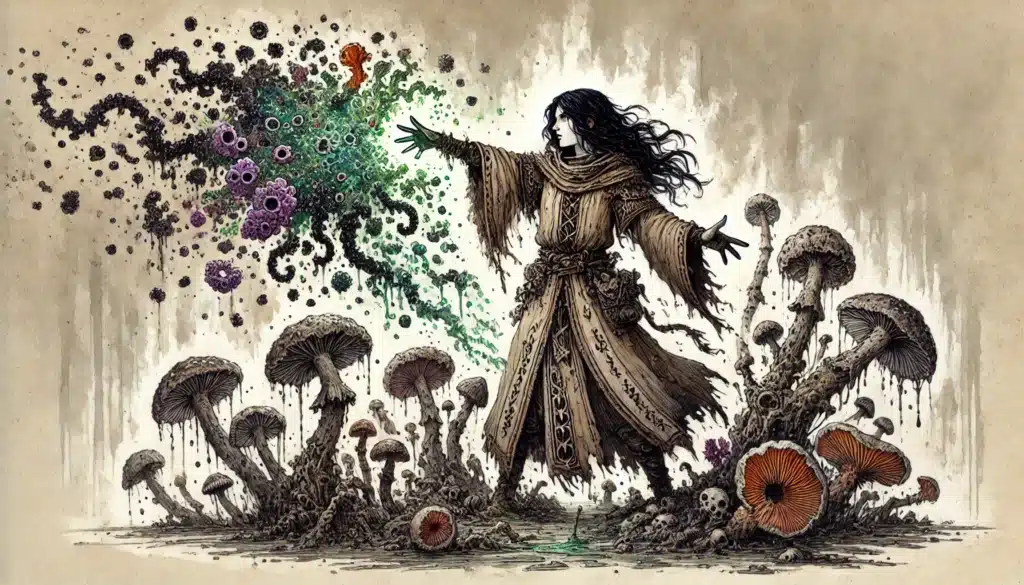
Tips for Balancing and Expanding Custom Magic Schools
Building a whole spell school from a single signature spell is a rare chance to shape campaign identity. To do so while maintaining balance, start by considering subclass integration. Maybe only unique subclasses, or those guided by certain NPCs, can access the full “curriculum.” You might let players learn one or two spells on a trial basis—adding more only after in-game milestones or side quests.
Spell scaling is crucial. Design lower-level “apprentice” versions with modest effects, then create “masterclass” rituals, area effects, or multi-target upgrades for higher-level characters. School-specific magical items—wands, rings, or tattoos—can further customize the experience, granting small per-day spell twists and new uses for spell slots.
Institutional presence enhances immersion. Anchor each school in the world: Glimmertruth heroes might wear their badges on public trial days, while Ironcall students endure annual “Hammer Festivals.” Let rival NPC casters present both competition and tutelage. These schools gain staying power when they’re inextricably linked to the world’s movers and shakers, with ongoing repercussions for their use and abuse.
Balancing custom schools requires constant tuning. Watch for combos or exploits that might break encounters—modify, restrict, or clarify as needed. Testing in one-shots, boss fights, or as enemy-only powers lets you debug before adding to player arsenals full-time.
Expansion Suggestions:
- Design unique school familiars with abilities tied to signature magic (fungal fungus for Witherhex, for example).
- Introduce school-specific skill challenges or rituals—puzzles only practitioners can solve.
- Award school-themed magical items with limited uses or unique triggers.
- Allow access to school “guildhouses” with exclusive libraries and teachers.
- Make rivals or nemeses—NPC spellcasters, assassins, or ex-cultists—who use the same school.
- Scale spells to mass effect—e.g., “city-wide Null Veil” for campaign finales.
- Unlock advanced forms of signature spells usable once per week or at legendary tier.
- Present unique social complications (regulations, prejudice, smuggling magical contraband).
- Allow inter-school “duels” or competitions as living world events.
- Inscribe magic into architecture or ley lines, giving territory tangible magical identity.
- Let spell slots be repurposed for school-only effects, creating tough strategic choices.
Building a custom school is a journey—each new spell, NPC, or institution reveals more possibilities. Encourage feedback, adapt, and remember: a single signature spell can launch hundreds of stories.
Whether you’re the DM sculpting lore or the player hungry for new power, lean into what makes your invention unique. Test liberally; adjust where needed—and celebrate the times when innovation surprises everyone at the table.
⚔️ Fantasy RPG Random Tables Books
Make life as a Gamemaster easier…
If you play Dungeons & Dragons, Pathfinder, or other fantasy RPGs, this
RPG random tables series
is packed with encounters, NPCs, treasure, and more. Available in eBook or print—either way, you’ll have a wealth of adventure ideas at your fingertips.
Final Thoughts on Homebrew Magic Schools
Homebrew magic schools aren’t just about blasting your foes with new flavors of fireball—they’re about weaving meaning into every encounter. Each school, with its dogma, risks, and wonders, offers a fresh lens on magic’s role in your campaign. They breathe life into NPC rivals, hint at lost civilizations, and raise the stakes for magical discoveries and duels.
The real value is in the storytelling. These schools invite players to forge distinctive magical identities—to become not just a “wizard” or “sorcerer,” but a Dreamscript illusionist twisting reality, or an Ironcall bruiser reshaping the battlefield. Tactical diversity leaps forward: every new mechanic shifts the dance of combat, encouraging improvisation and daring.
Of course, with great creativity comes the obligation to keep the game fair. Playtest your homebrew; be open to tweaks. But embrace the chaos—D&D is meant to surprise. The joys of a school’s first real moment, that “aha!” when the battlefield pivots because of a well-timed echo or a timely Glimmertruth reveal, are worth chasing.
Customization is the real magic. Don’t fear imbalance—fear stagnation. Iterate, adapt, and let your table’s enthusiasm guide you. Create guilds, feuds, and festivals around these schools. Develop rivalries and build living histories, letting the triumphs and missteps of these experimental magics ripple forever outward.
Above all, use these twelve epic schools as starting points. Let them sink roots, flower, and mutate. There’s no higher calling in D&D than co-creating something unforgettable—and in inventing magic, you’re changing the very shape of your worlds. Bright ideas and bold risks make for epic adventures.

